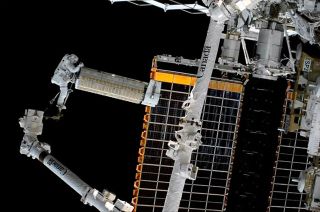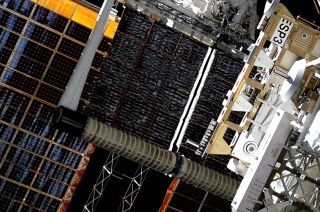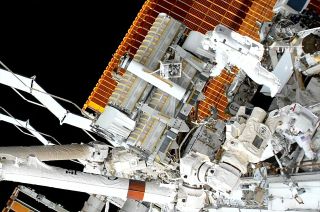NASA astronauts deploy roll-out solar array while spacewalking outside space station
Josh Cassada and Frank Rubio also partially restored electricity to a tripped space station power channel.
Two NASA astronauts helped augment and restore power to the International Space Station (ISS) during a seven-hour spacewalk on Saturday (Dec. 3).
Expedition 68 crewmates Josh Cassada and Frank Rubio deployed a new roll-out solar array and bypassed a short in one of the station's eight power channels on their second spacewalk together in as many weeks. The two completed all of the tasks set out for them by flight controllers, working right on schedule throughout the 7-hour, 5-minute extravehicular activity (EVA) outside the International Space Station.
"We're only efficient because of the plan that was put together. It is remarkable. And the team that got us suited and out on time did their job really well," Cassada radioed to Mission Control.
The spacewalkers began their outing at 7:16 a.m. EST (1216 GMT), switching their suits to internal battery power shortly before exiting the U.S. Quest airlock. From there, the two moved on to setting up their initial worksites and freeing one of two new ISS Roll-Out Solar Arrays (iROSA) from the carrier on which it was delivered by SpaceX's CRS-26 Dragon spacecraft on Nov. 27.
Related: The most memorable spacewalks of all time in pictures

Cassada also installed a foot restraint on the end of the station's robotic arm, which he next used to carry the 750-pound (340-kg) iROSA to its installation site on the station's starboard truss structure. NASA astronaut Nicole Mann and Koichi Wakata, a JAXA (Japan Aerospace Exploration Agency) astronaut, both on the Expedition 38 crew, operated the arm from inside the space station.
"Koichi, that was amazing. Thank you for the ride," said Cassada. "I will definitely get on my ride share app and give you five stars when I get back inside."

With the new array positioned atop its previously-installed bracket mount, Cassada and Rubio unfolded the iROSA assembly and then tightening bolts to hold it in place. Working in the dark, when the legacy solar array wings were not generating electricity, the astronauts ran cables to tie the new iROSA into the station's power supply.
Get the Space.com Newsletter
Breaking space news, the latest updates on rocket launches, skywatching events and more!
Back in daylight, Cassada released two bolts and the iROSA began to unfurl. The potential energy held by the array's rolled-up carbon composite booms was enough for it to unroll its full 63-foot (19 meter) length with no motor needed.
"That is incredible," sad Cassada, watching the solar array deploy.
"That is pretty cool," Rubio said.
Once the iROSA was fully-deployed, a process that took about 10 minutes, Cassada tightened two bolts to stiffen the array and its installation was complete.
The roll-out solar arrays are being installed in front of, and partially overlaying, the station's older, slightly-degraded solar panel wings. When used in tandem, the upgraded power system will increase the station's electricity supply by 20 to 30 percent.
A similar set of rollout arrays, only longer and deployed remotely, will be used to power NASA's Gateway lunar orbit platform when it is launched in the coming years.

With their iROSA work done and mission control seeing good power flowing through the newly-installed array, Cassada and Rubio split ways. Cassada returned to the iROSA carrier to begin freeing the second array as a get-ahead task for the next spacewalk now planned for Dec. 19. Rubio, meanwhile, moved over to the outboard solar array wing (1B) to disconnect a cable.
Flight controllers recently changed electrical power routing to remove the IB power channel from use to ensure its batteries were being charged at expected levels. Station systems normally powered by the 1B channel were switched over to use electricity from the 1A power channel with no impact to station operations.
By disconnecting one of four power connectors, Rubio restored redundancy for the affected systems after an unexpected short, or tripping was observed on the 1B channel on Nov. 26. By Rubio isolating a section of the impacted array — which was one of several damaged strings — flight controllers expected to be able to restore 75% of the 1B array's functionality.
Cassada and Rubio completed their spacewalk cleaning up and taking inventory of their tools before reentering the airlock at 2:21 p.m. EST (1921 GMT).
"This is the kind of day that makes you want to clap your hands. To the station we bring new power, more power generation restored than ever, so let MCC be heard to the ISS," said flight director Zeb Scoville as the team in the Mission Control Center at NASA's Johnson Space Center in Houston broke into applause at the conclusion of the spacewalk. "Let there be light. Good job!"
Saturday's excursion was the second spacewalk in both astronauts' careers. They now have logged 14 hours and 16 minutes working the vacuum of space.
The EVA was the 11th for the year, the third for Expedition 68 and 256th since 1998 in support of assembly and maintenance of the ISS.
Follow us @Spacedotcom, Facebook and Instagram.
Join our Space Forums to keep talking space on the latest missions, night sky and more! And if you have a news tip, correction or comment, let us know at: community@space.com.

Robert Pearlman is a space historian, journalist and the founder and editor of collectSPACE.com, an online publication and community devoted to space history with a particular focus on how and where space exploration intersects with pop culture. Pearlman is also a contributing writer for Space.com and co-author of "Space Stations: The Art, Science, and Reality of Working in Space” published by Smithsonian Books in 2018. He previously developed online content for the National Space Society and Apollo 11 moonwalker Buzz Aldrin, helped establish the space tourism company Space Adventures and currently serves on the History Committee of the American Astronautical Society, the advisory committee for The Mars Generation and leadership board of For All Moonkind. In 2009, he was inducted into the U.S. Space Camp Hall of Fame in Huntsville, Alabama. In 2021, he was honored by the American Astronautical Society with the Ordway Award for Sustained Excellence in Spaceflight History.
